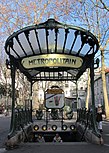Clockwise from top left: Paris Métro station Abbesses by Hector Guimard (1900); cover of Jugend magazine by Otto Eckmann (1896); wall cabinet by Louis Majorelle; interior of the Hôtel Tassel in Brussels by Victor Horta (1892–1893); lamp by Louis Comfort Tiffany (1900–1910) | |
| Years active | c. 1883–1914 |
|---|---|
| Location | Western world |
Art Nouveau (/ˌɑːr(t) nuːˈvoʊ/ AR(T) noo-VOH, French: [aʁ nuvo] ; lit. 'New Art') is an international style of art, architecture, and applied art, especially the decorative arts. It was often inspired by natural forms such as the sinuous curves of plants and flowers.[1] Other characteristics of Art Nouveau were a sense of dynamism and movement, often given by asymmetry or whiplash lines, and the use of modern materials, particularly iron, glass, ceramics and later concrete, to create unusual forms and larger open spaces.[2] It was popular between 1890 and 1910 during the Belle Époque period,[3] and was a reaction against the academicism, eclecticism and historicism of 19th century architecture and decorative art.
One major objective of Art Nouveau was to break down the traditional distinction between fine arts (especially painting and sculpture) and applied arts. It was most widely used in interior design, graphic arts, furniture, glass art, textiles, ceramics, jewellery and metal work. The style responded to leading 19th century theoreticians, such as French architect Eugène-Emmanuel Viollet-le-Duc (1814–1879) and British art critic John Ruskin (1819–1900). In Britain, it was influenced by William Morris and the Arts and Crafts movement. German architects and designers sought a spiritually uplifting Gesamtkunstwerk ('total work of art') that would unify the architecture, furnishings, and art in the interior in a common style, to uplift and inspire the residents.[2]
The first Art Nouveau houses and interior decoration appeared in Brussels in the 1890s, in the architecture and interior design of houses designed by Paul Hankar, Henry van de Velde, and especially Victor Horta, whose Hôtel Tassel was completed in 1893.[4][5][6] It moved quickly to Paris, where it was adapted by Hector Guimard, who saw Horta's work in Brussels and applied the style to the entrances of the new Paris Métro. It reached its peak at the 1900 Paris International Exposition, which introduced the Art Nouveau work of artists such as Louis Tiffany. It appeared in graphic arts in the posters of Alphonse Mucha, and the glassware of René Lalique and Émile Gallé.
From Britain, Belgium and France, Art Nouveau spread to the rest of Europe, taking on different names and characteristics in each country (see Naming section below). It often appeared not only in capitals, but also in rapidly growing cities that wanted to establish artistic identities (Turin and Palermo in Italy; Glasgow in Scotland; Munich and Darmstadt in Germany; Barcelona in Catalonia, Spain), as well as in centres of independence movements (Helsinki in Finland, then part of the Russian Empire).
By 1914, with the beginning of the First World War, Art Nouveau was largely exhausted. In the 1920s, it was replaced as the dominant architectural and decorative art style by Art Deco and then Modernism.[7] The Art Nouveau style began to receive more positive attention from critics in the late 1960s, with a major exhibition of the work of Hector Guimard at the Museum of Modern Art in 1970.[8]
- ^ Heilbrunn Timeline of Art History, Metropolitan Museum of Art, Art Nouveau
- ^ a b Sembach, Klaus-Jürgen, L'Art Nouveau (2013), pp. 8–30
- ^ Sterner (1982), 6.
- ^ Victor Horta Archived 19 April 2019 at the Wayback Machine – Encyclopædia Britannica
- ^ World Heritage Centre, UNESCO. "Major Town Houses of the Architect Victor Horta (Brussels)". whc.unesco.org. Archived from the original on 13 May 2013. Retrieved 26 December 2019.
- ^ Oudin, Bernard, Dictionnaire des Architectes Victor Horta article
- ^ "Art Nouveau", Heilbrunn Timeline of Art History, Metropolitan Museum of Art
- ^ Vigne, Georges, Hector Guimard – Le geste magnifique de l'Art Nouveau, (2016), Editions du Patrimoine, Centre des Monuments National, p. 194




